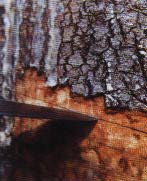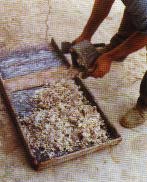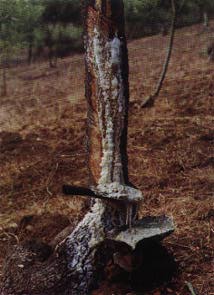Home |
Fraxinus images
Production of manna in Sicily
The photos and information below comes from a folder about manna production.
© Copyright by Consorzio Produttori di Manna della regione Siciliana, Castelbuono, Palermo.
How manna is obtained
Manna is obtained exclusively in the towns of Castelbuono, Pollina and Cefalù. It is obtained by making incisions with a knife in the trunks of some varieties of ash (Fraxinus ornus and F. angustifolia), from which the descending elaborated sap flows. The period of incision and harvesting lasts from the first ten days of July to September, but there is a close relationship between the climate during this period and the quantity produced.
When the bitter violet-coloured juice, which immediately gushes out of the incision, comes into contact with the air, especially under the baking hot Sicilian sun, it becomes sweet and solidifies on the trunk. This particular phenomenon is the result of the miraculous coincidence of various favourable environmental factors.
Harvesting takes place using special tools and two main qualities are produced: "cannolo" (cream bar) manna and "broken" or "worked" manna.
Characteristics and uses
Manna is a harmless substance without any side effects (its use is to be avoided only in the cases of intestinal occlusion, appendicitis, peritonitis and in particularly weak cases). The substance is a mild laxative and an excellent purgative. It is suitable in cases of indigestion, because of not being an irritant it does not cause gastritis or gasteroenteritis. It can also be used in atonic or spastic constipation; as a dehydrating and antitoxic agent in poisoning; in cases of endocranial hypertension; in apoplectic coma; as an anthelmintic when associated with santonin, Corsican moss and wormseed; an antirachitic; an expectorant, fluidifier, emollient and sedative in coughs; a decongestant, anodyne and abluent in chronic bronchitis, pharyngitis, laryngitis and tonsillitis when taken on its own or associated with extract of liquorice essence of hesperidium etc.; suitable for gargling, as a resolvent and disinfectant, when associated with copper and zinc salts, lemon juice, tannin, etc.; in hypertonic solutions it acts as a dehydrant in the treatment of wounds and ulcers, especially varicose ulcers, it helps reduce swelling and is known to be a rapid decongestant, detergent and cicatrizant; it can be used in a more or less concentrated solution in various gynaecological illnesses, especially when it is necessary to reduce an abundant secretion; in opthalmology in the form of an eyewash in various illnesses such as calcareous spots, leukoma and arcus senilis. It can be used as a sweetener in cases of diabetes as it does not affect glycemia levels or cause glycosuria. It is also a cholagogue as it promotes the flow of the contents of the gall bladder and bile ducts and so stimulates bile production. It helps smoothe rough and sensitive skin and it's also useful for softening and soothing boils and scalds.
More info on the uses of manna can be found here.
Research article about manna:
Oddo, E. & Sajeva, M. & Bellini, E. 2002. Seasonal pattern of mannitol and malate accumulation in leaves of two manna ash species (Fraxinus ornus L. and F. angustifolia Vahl) growing in Sicily. Plant biosystems 136(1): 29-34.
Manna can be obtained via this web site: www.mannadellemadonie.com
Four pictures showing harvesting of manna in Sicily

Incision of the trunk |

The solidified sap flow |

Harvesting of manna |

The collected raw manna |
© Consorzio Produttori di Manna della regione Siciliana, Castelbuono, Palermo.
Address:
Consorzio Produttori di Manna della regione Siciliana
Via Ten. Luigi Cortina, 43
I-900 13 Castelbuono (PA)
ITALY
phone: (0921) 671263
Maintained by Eva Wallander | Last updated: 2006-12-04





